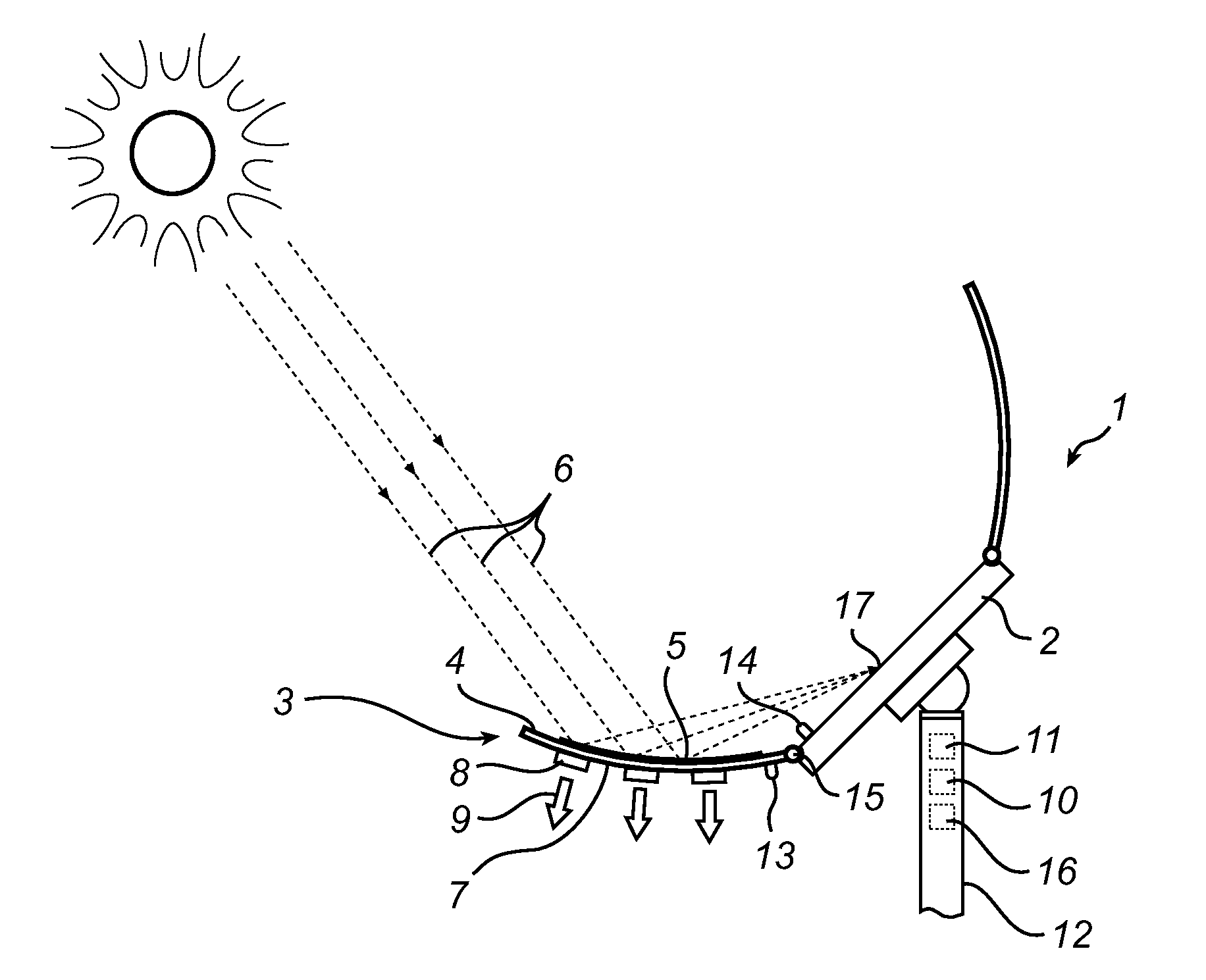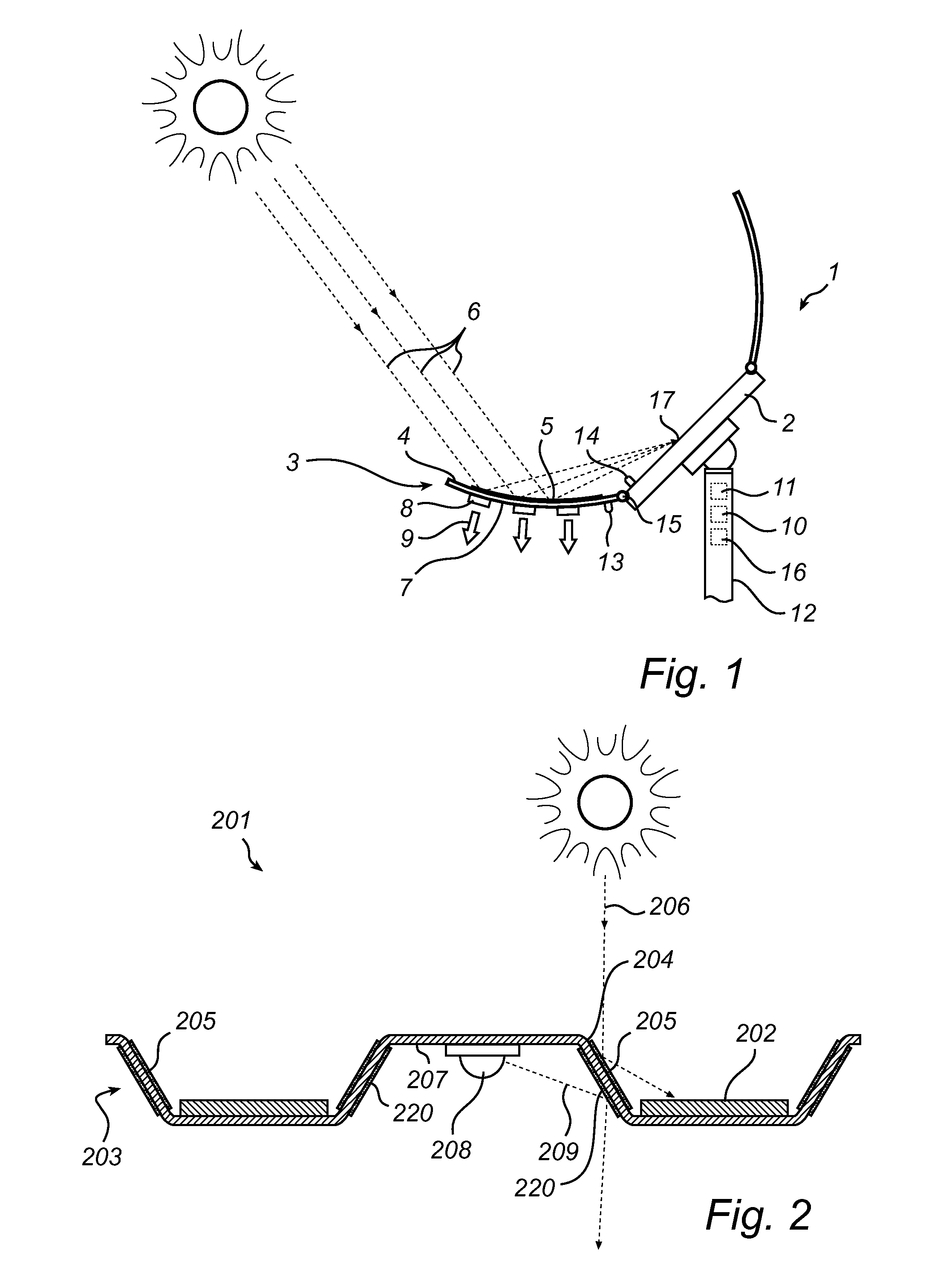Solar powered lighting arrangement
a solar energy and lighting technology, applied in fixed installations, lighting and heating equipment with built-in power, etc., can solve the problems that normal lighting solutions may not be feasible in many of these rural areas
- Summary
- Abstract
- Description
- Claims
- Application Information
AI Technical Summary
Benefits of technology
Problems solved by technology
Method used
Image
Examples
first embodiment
[0024]FIG. 1 illustrates an exemplifying solar powered lighting arrangement 1 in accordance with the present invention. For simplicity, the solar powered lighting arrangement 1 of FIG. 1 comprises a single solar cell 2. Note however, that more than one solar cell may be present with the solar powered lighting arrangement 1 such as an interconnected assembly of a plurality of solar cells. The illustrated single solar cell 2 may hence likewise be one or several solar panels which further may be provided with a covering hood for protection from the surrounding environment. It is to be understood that the solar cell 2 may be represented by any applicable solar cell or panel known in the art, and that the solar cell 2 may be adapted to generate electrical power in a known manner. In order to envisage the ability of the solar powered arrangement 1 to derive electrical power from the solar cell 2, a means for deriving electrical power 10 is illustrated. The means for deriving electrical po...
second embodiment
[0035]FIG. 2 presents an exemplifying solar powered lighting arrangement 201 in accordance with the present invention. The illustrated solar powered lighting arrangement 201 resembles that 1 described in conjunction with FIG. 1, why only distinctive differences are discussed in the following.
[0036]The solar powered lighting arrangement 201 of FIG. 2 is in contrast to that of FIG. 1 shaped to be convenient for instance for indoor lighting. The structural member 203 is here a large structure making part of a corrugated roof of a simple shed, with the first side 204 of the structural member 203 facing the sun and the second side 207 facing the inside of the shed. Note that the structure 203 neither necessarily is corrugated, nor necessarily is part of a roof; other implementations may likewise be applicable.
[0037]The solar powered lighting arrangement 201 here comprises a plurality of solar cells or panels 202 arranged on top of the structural member 203, i.e. on the first side 204. Th...
third embodiment
[0040]FIG. 3 illustrates in a three-dimensional view an exemplifying solar powered lighting arrangement 301 in accordance with the present invention. The illustrated solar powered lighting arrangement 301 resembles those described in conjunction with FIGS. 1 and 2, why only distinctive differences are discussed in the following.
[0041]The structural member 303 of FIG. 3 is here a large structure making part of a corrugated metal roof, and may hence similar to the second embodiment of FIG. 2 be convenient for instance for indoor lighting. The solar powered lighting arrangement 301 of FIG. 3 comprises a plurality of solar cells or panels 302 arranged across the first side 304 of the structural member 303 and a plurality of light sources 308 arranged across the second side. Each solar cell 302 is here provided with four first reflective surfaces 305 for directing sunlight towards the corresponding solar cell 302, and two light sources 308. Note that the positioning as well as the number...
PUM
 Login to View More
Login to View More Abstract
Description
Claims
Application Information
 Login to View More
Login to View More - R&D
- Intellectual Property
- Life Sciences
- Materials
- Tech Scout
- Unparalleled Data Quality
- Higher Quality Content
- 60% Fewer Hallucinations
Browse by: Latest US Patents, China's latest patents, Technical Efficacy Thesaurus, Application Domain, Technology Topic, Popular Technical Reports.
© 2025 PatSnap. All rights reserved.Legal|Privacy policy|Modern Slavery Act Transparency Statement|Sitemap|About US| Contact US: help@patsnap.com



